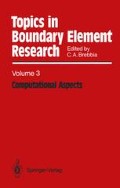Abstract
The following paper represents a considerable development of the paper, Quinlan and O’Callaghan (1984), presented at the Sixth International Conference of B.E.M. in Engineering and published in the Conference proceedings. The section on curved boundaries has been greatly expanded with appropriate examples.
Access this chapter
Tax calculation will be finalised at checkout
Purchases are for personal use only
Preview
Unable to display preview. Download preview PDF.
References
Sokolnikoff, I.S. (1956), The Mathematical Theory of Elasticity, McGraw-Hill
Quinlan, P.M. (1964), The Torsion of an Irregular Polygon, Proc. Roy. Soc., Vol. 282 A
Quinlan, P.M. (1968), Polygon and Swept-Back plates with Cut-Outs and Column Supports, Proc. OAR Research Applications Conference, Washington 1968
Quinlan, P.M. (1971), Final Scientific Report on Grant AF EOAR-69–0049, with Program QUINP. Cork University
Desmukh, R.S. (1973), The Edge-Function Method Applied to Moderately Thick Plates and Shallow Shells, Ph.D. Thesis, University of Massachusetts
Tai, I.H. and Nash, W.A. (1973), Vibrations of Thin Plates — A New Approach, AFOSR TR-74–0789, University of Massachusetts
Quinlan, P.M. (1974), The Edge-Function Method in Elastostatics, paper in Studies in Numerical Analysis, Academic Press, London 1974
O’Callaghan, M.J., Nash, W.A., and Quinlan, P.M. (1975), Vibration Analysis of Thin Shallow Spherical Shells Using the Edge-Function Method, AFOSR TR-72–2340, University of Massachusetts
Quinlan, P.M., Fitzgerald, J.E., and Atluri, S.N. (1977), The Edge-Function Method, Proceedings First International Symposium on Innovative Numerical Methods in Engineering Science, Versailles
Quinlan, P.M., Grannell, J.J., Atluri, S.N., and Fitzgerald, J.E. (1979), Boundary Discretisation using the Edge-Function Method, App. Math. Modelling, 3, 1979
Grannell, J.J. and Quinlan, P.M. (1980), The Edge-Function Method for Thin Aeolotropic Plates, Proc. Roy. Irish Academy
Parker, A.P. (1981), The Mechanics of Fracture and Fatigue, E.S.F.N. Spon, London
Quinlan, P.M. Grannell, J.J., Atluri, S.N., and Fitzgerald, J.E. (1982), The Edge-Function Method for Three-Dimensional Stress Analysis, included Embedded Elliptical Cracks, Proceedings of the Fourth International Conference on Boundary Element Methods in Engineering
Quinlan, P.M. and O’Callaghan, M.J.A. (1984), The Edge-Function Method (E.F.M.) for Cracks, Cavities, and Stress Concentrations in Elastostatics, Proceedings of the Sixth International Conference on Boundary Element Methods in Engineering
Editor information
Editors and Affiliations
Rights and permissions
Copyright information
© 1987 Springer-Verlag Berlin, Heidelberg
About this chapter
Cite this chapter
Quinlan, P.M., O’Callaghan, M.J.A. (1987). The Edge Function Method (E.F.M.) for Cracks, Cavities and Curved Boundaries in Elastostatics. In: Brebbia, C.A. (eds) Computational Aspects. Topics in Boundary Element Research, vol 3. Springer, Berlin, Heidelberg. https://doi.org/10.1007/978-3-642-82663-4_5
Download citation
DOI: https://doi.org/10.1007/978-3-642-82663-4_5
Publisher Name: Springer, Berlin, Heidelberg
Print ISBN: 978-3-642-82665-8
Online ISBN: 978-3-642-82663-4
eBook Packages: Springer Book Archive

